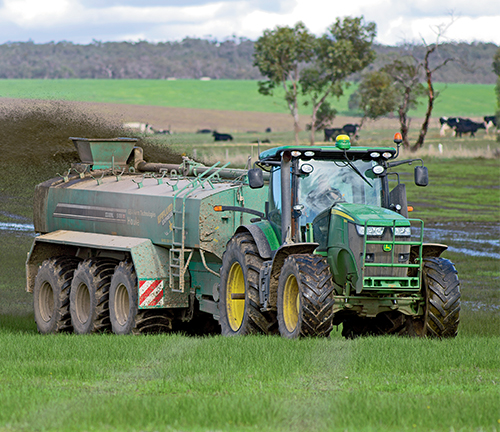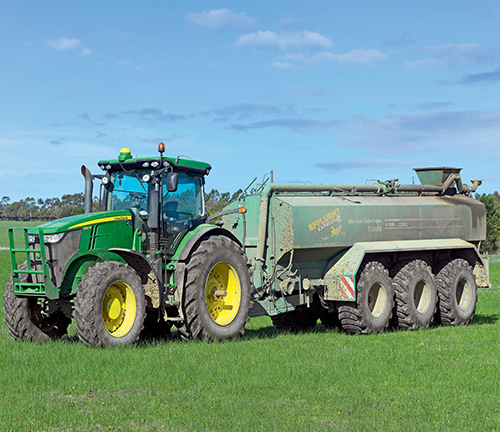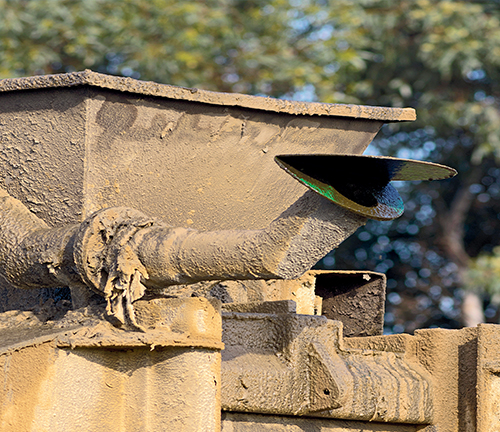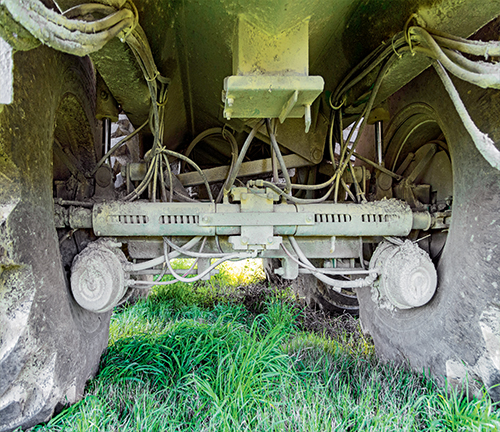GEA’s Houle El44-6D manure spreader and 24-foot Articulated Super Pump make a great combo, writes Tom Dickson.
I discovered that while they are both great pieces of individual equipment, they also complement each other beautifully and, in fact, work best as a team.
The pump and spreader combo can best be described using sporting analogies.
The spreader is like a sprinter performing at top pace in very short bursts.
The pump, on the other hand, is the marathon runner in the squad, for hour after hour it slogs it out in sometimes difficult conditions and doesn’t rest until the job is done.
EFFLUENT EXPRESS
Twelve months ago, Glenn Logan of Logan contracting bought his first Houle spreader from dairy equipment specialist GEA Farm Technologies.
Its performance surpassed his expectations to such an extent that he now has four of the giant spreaders in his fleet.
According to Logan, the most efficient combination is two spreaders and a super pump working together. Logan has set up two spreading outfits to service the dairy industry.
Each outfit consists of two EL44-6D Houle spreaders, one 24-foot Articulated Super Pump, and a suitably sized tractor – 160-200hp – for each.
Logan operates an agricultural contracting operation throughout country Victoria, with the bulk of his business coming from hay and silage production, seeding, fertilising
and cultivation.
“I bought the spreaders to give my company another income stream during the quieter times in autumn, but I am getting increasing amounts of work during spring as well, getting pond effluent out onto paddocks after the first cut of silage,” he says.
“Common rates of application are around 60,000 litres per hectare, and research is indicating that the benefits of applying effluent to the pasture recoups the cost of application in around three weeks.”
Each of Logan’s spreaders have a roadrunner with the catchy slogan Effluent Express blazoned down the side of it. Once work began, it soon became apparent why.
With filling time less than two minutes and discharge taking only about two minutes and 30 seconds, the team of two spreaders can easily empty a one-megalitre effluent pond in less than five hours.
The majority of the time is spent shuttling between the paddock and the pond.
 |
|
GEA’s Houle El44-6D manure spreader and 24-foot Articulated Super Pump work well together.
|
EL44-6D
For over 18 years, GEA Houle Inc. has designed and manufactured effluent spreader tanks of various shapes and sizes, with options to best suit the needs of the end user.
Logan’s, EL44-6D model is a 23,300-litre tri-axle version.
It arrived at his Cobden workshop in a 40-foot shipping container, then took about three days to refit the wheels and various other componentry before it was ready for operation.
The standout features of the giant spreader that assist with manoeuvrability, safety and handling are power steering, load sharing hydraulic suspension and an air braking system.
It is not a vacuum tanker, rather a reservoir that is filled by means of a separate pump.
A 1000rpm PTO-driven pump delivers effluent to a single deflector plate mounted high at the rear of the spreader.
The single splash plate distributor is a simple and easy-to-use distribution system.
The deflector plate creates a 15m-wide spread with each pass. The spreader is designed to allow retrofitting of other types of toolbars at a later date.
Abrasion resistant steel is used in the construction of the pump and impeller housing to cut down on wear.
If a rock happens to find its way into the tank, an inline rock trap collects it before it reaches the pump to reduce possible damage to the pump.
The tank is manufactured from 6.0mm thick steel with internal baffles for stability and structural strength.
It is coated with a layer of Epoxy primer and two layers of Urethane paint, making it resistant to extreme conditions.
A hydraulically operated diverter valve achieves in-tank recirculation by redirecting flow away from the deflector plate and back into the tank. The diverter valve operates off one set of the tractors remotes. A second set is required for the power steering system.
The air brake assembly can best be described as being similar to that found on trucks.
The air brakes ensure maximum stopping power of the spreader, which, when full, has a total weight of around 32 tonnes.
These brakes can achieve up to 14.75 feet/sec2 of deceleration and meet ASABE standards. This braking system means the tractor has to have air delivery lines fitted to the rear.
Mud guards and all safety lighting is fitted to comply with Australia’s road transportation regulations. A K80 ball hitch is used to provide a tight coupling between the tractor and spreader while allowing an excellent range of movement.
Six Honey Wagon 725/65-26 floatation tyres are used for minimal impact on the ground surface, even in soft conditions.
 |
|
Logans has four of these units racing around country Victoria.
|
IN ACTION
As we left the pond and started our journey up the laneway, Logan disengaged the power steering.
He stressed that it is a fantastic aid for low-speed manoeuvrability and operation in the paddock, but out on the road at high speed it can make the spreader a bit unpredictable.
When disengaged, the wheels are kept straight in line with the spreader by means of heavy-duty compression springs.
As we slowed down to turn into the paddock, he re-engaged the power steering by opening up the appropriate set of remotes on the tractors hydraulics.
The air braking system is a must-have addition, and I reckon without that bit of extra stopping power, the fully laden spreader could have easily taken control and pushed us passed the gateway.
As we started to turn into the gateway, I saw just how valuable the power steering is.
Everyone in the industry knows that modern dairy farm design maximises pasture space and minimises laneway width, so without steering assist it would be quite awkward to manoeuvre a spreader of this size around the narrow network of laneways.
The front set of wheels turn in to follow the tractor and rear set turn out to prevent the back of the spreader from cutting in. Each set of wheels on the 9.71m-long spreader followed the wheel tracks of the tractor throughout the whole turn.
I also noticed that it hardly left a mark in the soft paddock surface even when turning sharp.
The front tyres of the tractor left more of a footprint than the 32-tonne spreader does.
It should be able to work longer into the wetter months, whereas non-steerable spreaders would scuff up the ground too much.
SAFETY FIRST
For safety’s sake, and to ensure no-one accidently gets showered in sh#t, he makes sure the diverter valve is set to the recirculating position, directing flow back into the tank before he turns on the PTO pump.
Travelling at 4.0km/h, the flow of effluent can now be switched back to the deflector plate with the second set of remotes.
If he has to stop the flow for turning, he leaves the PTO running and recirculates the flow back into the tank. He believes switching the PTO on and off causes undue stress on the driveline and pump.
Within about two and a half minutes and 200 metres of travel, the entire 23,300-litre load has been applied to the recently sown pasture in an even spread pattern about 15m-wide.
This load is going onto pasture that has shot and is up about 5.0cm.
Another common practice is to drive at about 1.0km/h to give four times the rate of application then cultivate the effluent into the soil prior to sowing.
To anyone who doesn’t know what’s going on, it must be a puzzling sight to see a massive fountain of muck showering out onto the fresh green pasture, instantly turning it black.
Unlike many modern machines on the market, the Houle spreader is exceptionally simple to operate.
An inexperienced operator only needs to be shown how to turn on the PTO to activate the pump and use one set of hydraulics to direct flow to either the deflector plate or back into the tank. Simple as that.
 |
|
The single splash plate distributor is a simple and easy to use distribution system. The spreader is designed to allow retrofitting of other types of toolbars at a later date.
|
SUSPENSION
I couldn’t find any rough ground, but a reasonably deep drain gave me a bit of an idea whether the hydraulic suspension is any good.
Each wheel has its own hydraulic suspension ram, and each ram is connected to allow oil to flow from one to another to maintain equal pressure in each as it follows undulations in the ground.
Each of the three axles is attached under the tank by four sway bars and one cross member mounted on rubber bushings.
The 30cm stroke suspension distributes weight evenly on all wheels for smoother travel over irregular terrain and reduces stress to the reservoir.
Basically, it means that as I watched all the wheels dip and rise through the drain independently of each other, the spreader tank stayed perfectly level.
This design ensures that every wheel shares an even amount of load.
The chromed kingpins on the front and rear steerable axles are mounted with greasable brass bushes.
After entering the paddock only three minutes earlier, we were on our way back to the pond for another load.
Jumping out to watch it go through a drain is the only time I set foot outside.
In normal working conditions, the driver never has to leave the confines of the cabin.
An 18-inch taper hopper on the fill opening includes a flapper door to prevent effluent splashing back out of the top when the mixture surges inside the tank.
It has a mechanical rear fill indicator to alert the operator that the tank is nearly full.
A set of LED rear work lights on the spreader assist with night activities.
Furthermore, to reduce the time and effort spent on maintenance, a complete axle lubrication kit has been fitted to each corner of the spreader.
KEY
The key factor is definitely the ability to operate the filling process remotely from inside the cabin of the spreader tractor.
It keeps the driver inside the cabin, away from the elements and, more importantly, the stench that sometimes lingers around the banks of an effluent pond.
 |
|
The hydraulically operated diverter valve directs flow to either the deflector plate or back into the tank for recirculation.
|
A SUPER PUMP
To complement his spreaders, Logan took possession of not one, but two GEA 24-foot long articulated PTO super pumps.
While the pump is not loading the spreader, it is continually agitating the effluent in the pond.
His include an eight-inch articulated loading arm option and remote control operation.
The three-point linkage mounted Super Pump is suitable for agitation of effluent ponds with steep sides and in-ground storage tanks.
It can process very thick manure with high fibre content. A minimum 140 PTO horsepower is recommended to drive the pump.
I noticed the weight and length of the pump caused the tractor to rock around a lot when backing up to the edge of the pond, so for safety as much as power requirements, you’re going to need a decent size tractor to operate it.
Once the impeller pump with self-cleaning blades has been carefully punched down through the hard crust that has formed on the surface, and the PTO is engaged, it starts aggressively smashing the crust and sludge into a spreadable consistency.
Every movement and function of the pump is operated via a remote controller from inside each of the spreader tractors.
The official specifications brochure states that the Super Pump can load spreaders at very high flow rates up to 11,000 litres per minute, but we actually found it to be even quicker than that at 12,000 litres per minute.
As we backed up to the pump for loading, Logan grabbed the remote. Using the remote, he swung the articulated eight-inch loading arm out and dropped it into the hopper at the rear of the spreader – he then directed effluent flow into the tank.
Then, when filling was complete, he sent flow back to agitation nozzle.
The handheld remote control unit also changes the direction of the high pressure agitation gun to flush down the banks of the pond to ensure thorough emptying of the pond.
Within about two minutes, we were back up the track with another full load.
Vacuum tankers can fill themselves, but you have to physically get out and connect the suction hoses for each fill, and there is still the need for an agitation pump.
So, if you have to have an agitation pump, you may as well have one like this that can fill the spreader as well.
 |
|
A maze of hydraulic and air hoses service the suspension cylinders, double-ended power steering ram, and air brake system.
|
OVERALL
The only component that has had to be replaced is a couple of cables that form part of the steering mechanism.
GEA has done a fantastic job with the Houle spreader.
Its build quality is of the highest standard, and its speed and accuracy of application is up there with the best. For a machine of considerable weight, it handles very well.
Many of its rivals would leave massive footprints in the soft soil, but Logan’s spreader hardly left a trace.
Farming can often be a shitty job, so any machine that helps isolate you from the crap gets my tick of approval.
With the GEA Houle spreader and the remote controlled super pump, you don’t leave the cabin till the job is finished.
Hits
- Power steering
- Hydraulic suspension
- Air brakes
- Remote controlled super pump
- Simple operation
- Full tank indicator
Misses
- Steering cables
If you’re looking for farm machinery for sale, check out our listings.
Video: Andrew Britten

